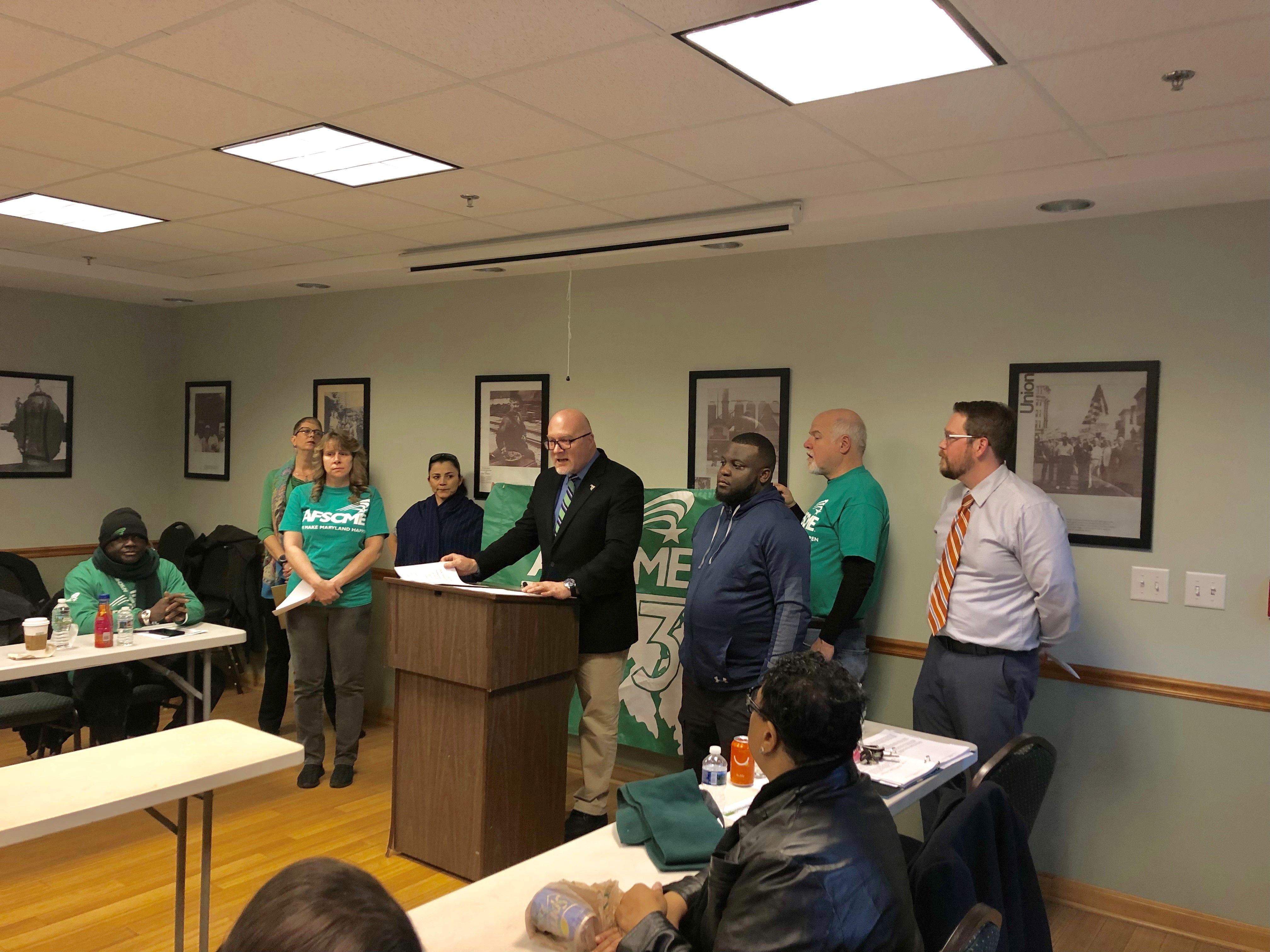ANNAPOLIS — Maria Ayala, a housekeeper in the Edward St. John Learning and Teaching Center, has worked at the University of Maryland for almost 14 years. But she said she hasn’t gotten a raise in five years, and she must work a second job cleaning apartments and houses to make ends meet.
“I have kids. I have bills to pay,” Ayala said. “You cannot live with that pay we get.”
With only a few days remaining before Gov. Larry Hogan releases his budget for the 2020 fiscal year, Ayala and other university employees rallied Monday in Annapolis to demand staffing increases and raises for state workers.
Members of the American Federation of State, County and Municipal Employees Council 3 union — many of whom work at the state’s public institutions of higher education — called for a portion of last fiscal year’s $504 million budget surplus to go toward pay and staffing increases.
Hogan’s budget was finalized as of last week and is already on its way to the State House, according to Angela Berard, a spokesperson for the governor. It’s set to be released Friday.
[Read more: Dozens of UMD housekeepers say they’ve gotten sick from cleaning mold]
Hogan has announced agreements with the state’s four other public employee unions: the Fraternal Order of Police Lodge 34; the Maryland Professional Employees Council; the State Law Enforcement Officers Labor Alliance; and the American Federation of Teachers Healthcare Maryland.
But AFSCME Council 3 president Patrick Moran said at a press conference that the Hogan administration has been unwilling to compromise with the union. AFSCME Council 3 represents more than 28,000 state employees — more than all other state employee unions combined.
Negotiations with the Hogan administration have been unsuccessful over the past five months. Moran said the administration has insisted that AFSCME Council 3 limit its communications about the negotiations with its members, the press and the Maryland General Assembly.
“This behavior of the Hogan administration clearly shows that they are obstructionists,” Moran said.
In an emailed statement, Amelia Chasse, a spokesperson for the governor, rebutted Moran’s comments.
“AFSCME’s union bosses don’t have a clue what’s in the governor’s budget, but it’s unsurprising that they are again trying to mislead their members about their failure to come to the negotiating table, unlike every other public employee union,” Chasse said in the statement. “Here’s a prediction based on something other than wild speculation: when the governor’s budget is released, AFSCME members will have further proof that Patrick Moran is not an honest or effective advocate.”
[Read more: “I feel humiliated”: UMD housekeepers say they’ve been rebuked for speaking Spanish]
Last year, Hogan announced a 2 percent cost-of-living adjustment effective January 1, 2019 for all state employees. If revenues for fiscal year 2018 exceeded December 2017 projections by $75 million, Hogan pledged that state employees would also receive an additional half-percent merit increase and a one-time $500 bonus on April 1, 2019.
But with the $504 million surplus, AFSCME members are looking for a larger share of the funds. In October, hundreds of state employees, several of them from this university, rallied outside the Governor’s Mansion for higher salaries.
On Monday, members were asked to sign a letter to be delivered to Hogan’s office, and add personal anecdotes.
“We are understaffed, overworked and falling out of the middle class due [to] our wages not keeping pace with rising costs,” the letter states.
Warren Pointer, an electronics technician at this university’s business school, has worked at the university for 16 years. He said he hasn’t received performance review and development increases — raises based on merit and separate from cost of living increases — for five years.
Pointer said those who perform well on their performance reviews are supposed to get merit increases, but instead have been told there is no money available.
According to this university’s human resources website, “All merit pay and salary action decisions are subject to and defined by current pay policies and salary guidelines, as distributed to departments through the annual budget process.”
“They say they don’t have money, but they have $500 million in the budget,” Pointer said.
Pointer said the Thriving Workplace Initiative, a program introduced by university President Wallace Loh in 2016 to help employees feel more involved and valued, fails to live up to its mission.
“You can’t just say we’re going to have a thriving workplace — you’ve got to back that up with regularly scheduled increases so that people want to come to work at the University of Maryland,” Pointer sad. “So far, it’s just been lip service and there’s nothing behind it.”
Sally Davies, the vice president of this university’s AFSCME local, said there’s “a general level of frustration” among university employees, who see continued development on campus but have little to show for it in their paychecks.
“All of this is going on, but there’s no money to pay employees,” Davies said. “A fearless idea is to pay your employees properly.”
Thanks to its new contract, the union can negotiate directly with the university administration to determine wage increases. Davies said the union expects to meet with Loh in February in hopes of bargaining a better distribution of funds that come from the state and other sources.
Workers are still optimistic about the future, Davies said, and they need to continue to be “persuasive and persistent” to achieve the “raises and the rights and the respect” that all university employees deserve.
“People work at the university because they care about the mission, they care about doing their jobs in an excellent way,” she said. “They support the students — they are the first concern of everybody that works there.”



